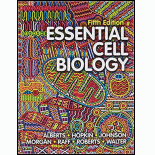
Concept explainers
A.
To calculate: The number of ATP molecules generated from one glucose molecule.
Introduction: During
A.
Explanation of Solution
Given,
Free energy (ΔG) for 1 mole of glucose = 2867 kJ
Chemical energy for phosphate bond of 1 mole ATP = 50 kJ
A maximum of 57 molecules are generated from one molecule of glucose.
B.
To calculate: The overall efficiency of ATP production from glucose as compared to the answer in part (A).
Introduction: Energy is required by cells to carry out metabolic activities. Cells can do so by yielding the energy stored in glucose molecules. This process is called glucose
B.
Explanation of Solution
Refer to the Table 14-1, “products yields from glucose oxidation”, in the text book.
Given,
Respiration produces 30 moles of ATP from 1 mole of glucose.
An overall efficiency of ATP production would be about 53%.
C.
To calculate: The increase amount of energy that heats the body.
Introduction: During cellular respiration, nutrients converted into ATP. This process releases energy and leads to the formation of stronger bonds in the products. Glucose breaks down into simpler molecules and produces energy in the form of ATP.
C.
Explanation of Solution
Given,
Body weight = 75kg
The temperature of the body increases by 4.3°C, if the heat is not dissipated into the environment.
D.
To explain: The effect on the body when body converts the energy in food substances with 20% efficiency.
Introduction: In cellular respiration, oxygen reacts intracellularly with organic compounds to form water, carbon dioxide, and ATP as a source of energy.
D.
Explanation of Solution
If body converts the energy in food substances with 20% efficiency, then 80% of available energy would be released as heat. The heat production would be higher than the normal. Hence the body would certainly overheat.
E.
To calculate: The amount of glucose from oxidation to produce energy.
Introduction: Cells can do so by yielding the energy stored in glucose molecules. This process is called glucose metabolism as glucose is converted to forms which can be easily used by the cell such as ATP.
E.
Explanation of Solution
Given,
A resting body hydrolyzes about 40 kg of ATP in every 24 hours.
Refer to the Fig. 2-24, “Adenosine triphosphate (ATP) is a crucially important energy carrier in cells”, in the text book. The molecular formula of ATP is C10H12O13N5P3.
1000 kcal chemical energy could be produced by the oxidation of 480 g glucose.
Want to see more full solutions like this?
Chapter 3 Solutions
Essential Cell Biology 5e
- 22. Which of the following mutant proteins is expected to have a dominant negative effect when over- expressed in normal cells? a. mutant PI3-kinase that lacks the SH2 domain but retains the kinase function b. mutant Grb2 protein that cannot bind to RTK c. mutant RTK that lacks the extracellular domain d. mutant PDK that has the PH domain but lost the kinase function e. all of the abovearrow_forwardWhat is the label ?arrow_forwardCan you described the image? Can you explain the question as well their answer and how to get to an answer to an problem like this?arrow_forward
- Describe the principle of homeostasis.arrow_forwardExplain how the hormones of the glands listed below travel around the body to target organs and tissues : Pituitary gland Hypothalamus Thyroid Parathyroid Adrenal Pineal Pancreas(islets of langerhans) Gonads (testes and ovaries) Placentaarrow_forwardWhat are the functions of the hormones produced in the glands listed below: Pituitary gland Hypothalamus Thyroid Parathyroid Adrenal Pineal Pancreas(islets of langerhans) Gonads (testes and ovaries) Placentaarrow_forward
- Describe the hormones produced in the glands listed below: Pituitary gland Hypothalamus Thyroid Parathyroid Adrenal Pineal Pancreas(islets of langerhans) Gonads (testes and ovaries) Placentaarrow_forwardPlease help me calculate drug dosage from the following information: Patient weight: 35 pounds, so 15.9 kilograms (got this by dividing 35 pounds by 2.2 kilograms) Drug dose: 0.05mg/kg Drug concentration: 2mg/mLarrow_forwardA 25-year-old woman presents to the emergency department with a 2-day history of fever, chills, severe headache, and confusion. She recently returned from a trip to sub-Saharan Africa, where she did not take malaria prophylaxis. On examination, she is febrile (39.8°C/103.6°F) and hypotensive. Laboratory studies reveal hemoglobin of 8.0 g/dL, platelet count of 50,000/μL, and evidence of hemoglobinuria. A peripheral blood smear shows ring forms and banana-shaped gametocytes. Which of the following Plasmodium species is most likely responsible for her severe symptoms? A. Plasmodium vivax B. Plasmodium ovale C. Plasmodium malariae D. Plasmodium falciparumarrow_forward
 Human Anatomy & Physiology (11th Edition)BiologyISBN:9780134580999Author:Elaine N. Marieb, Katja N. HoehnPublisher:PEARSON
Human Anatomy & Physiology (11th Edition)BiologyISBN:9780134580999Author:Elaine N. Marieb, Katja N. HoehnPublisher:PEARSON Biology 2eBiologyISBN:9781947172517Author:Matthew Douglas, Jung Choi, Mary Ann ClarkPublisher:OpenStax
Biology 2eBiologyISBN:9781947172517Author:Matthew Douglas, Jung Choi, Mary Ann ClarkPublisher:OpenStax Anatomy & PhysiologyBiologyISBN:9781259398629Author:McKinley, Michael P., O'loughlin, Valerie Dean, Bidle, Theresa StouterPublisher:Mcgraw Hill Education,
Anatomy & PhysiologyBiologyISBN:9781259398629Author:McKinley, Michael P., O'loughlin, Valerie Dean, Bidle, Theresa StouterPublisher:Mcgraw Hill Education, Molecular Biology of the Cell (Sixth Edition)BiologyISBN:9780815344322Author:Bruce Alberts, Alexander D. Johnson, Julian Lewis, David Morgan, Martin Raff, Keith Roberts, Peter WalterPublisher:W. W. Norton & Company
Molecular Biology of the Cell (Sixth Edition)BiologyISBN:9780815344322Author:Bruce Alberts, Alexander D. Johnson, Julian Lewis, David Morgan, Martin Raff, Keith Roberts, Peter WalterPublisher:W. W. Norton & Company Laboratory Manual For Human Anatomy & PhysiologyBiologyISBN:9781260159363Author:Martin, Terry R., Prentice-craver, CynthiaPublisher:McGraw-Hill Publishing Co.
Laboratory Manual For Human Anatomy & PhysiologyBiologyISBN:9781260159363Author:Martin, Terry R., Prentice-craver, CynthiaPublisher:McGraw-Hill Publishing Co. Inquiry Into Life (16th Edition)BiologyISBN:9781260231700Author:Sylvia S. Mader, Michael WindelspechtPublisher:McGraw Hill Education
Inquiry Into Life (16th Edition)BiologyISBN:9781260231700Author:Sylvia S. Mader, Michael WindelspechtPublisher:McGraw Hill Education





